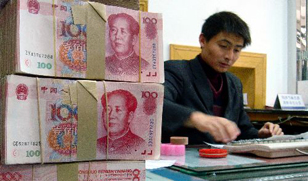

China's central bank moved a step further to tighten liquidity amid increasing inflation pressures as it ordered Chinese banks to set aside more reserves on Wednesday.
The People's Bank of China, or the central bank, announced it would raise the deposit reserve requirement ratio (RRR) for Chinese financial institutions that accept deposits by 50 basis points from Nov. 16, which was estimated to freeze more than 300 billion yuan (45.1 billion U.S. dollars).
The order came on the eve of Thursday's release of China's October consumer price index (CPI), which is projected, by some economists, to reach 4 percent.
The RRR for the four big state-owned banks - the Industrial and Commercial Bank of China, China Construction Bank, Bank of China and Agricultural Bank of China - will stand at 18 percent once the rise takes effect.
Further, Wednesday's move will raise the deposit reserve ratio for other large financial institutions to 17.5 percent and that for small-and medium-sized financial institutions to 15.5 percent.
The adjustment is the fourth RRR increase the central bank has ordered for Chinese banks this year, and the first time it has done so since it hiked interest rates by 0.25 percentage points last month.
Chinese experts believe combined concerns, ranging from the looming hot money inflows caused by the United State quantitative easing to the growing inflation risks and soaring assets bubbles, have caused the central bank to raise the RRR to rein in liquidity.
"The central bank announced interest rates hikes and the RRR rise within one month, as the U.S. 600 billion-US-dollar quantitative easing is likely to send more speculative capital flowing to the emerging markets, and domestic commodities prices continue to increase," senior economist with the Asian Development Bank, Zhuang Jian said, adding that the RRR increase will trim the banks' credit capital, which will help curb market speculation inflows and stabilize commodities prices.
China's central bank, on Oct. 20, announced a rise of its benchmark one-year lending and deposit rate by 0.25 percentage points, the first interest rates hike in three years, as the nation's CPI hit a 23-month high to 3.6 percent in September.
October's CPI is due to be announced on Thursday, while economists anticipate the October year-on-year inflation is likely to rise to 4.1 percent.
Further, prices of China's edible farm produce have witnessed consecutive increases since mid-October, as prices of 18 types of vegetables in 36 large and medium-sized cities rose by 4.9 percent during the week that ended Nov. 7, according to data released Wednesday by the Ministry of Commerce.
Zhang Ping, head of the National Development and Reform Commission, said Tuesday that the nation's CPI is expected to exceed the government' s annual target of 3 percent.
Also, the nation's real estate prices continued the upward trend in October, though at a slower pace, with property prices in 70 major Chinese cities increasing by 8.6 percent year on year in October, down from the 9.1-percent increase in September, the National Bureau of Statistics showed Wednesday.
Li Huaiding, analyst with the Guoxin Securities Co., said Wednesday's rise would contribute to scaling back liquidity, but pressures still exist in the upcoming months, and the central bank may again increase interest rates before the end of the year.
Additionally, the central bank said in a report issued on Nov.2 that it would gradually normalize the monetary policy from its counter-crisis mode and tighten control over liquidity to maintain moderate credit growth in the coming months this year.